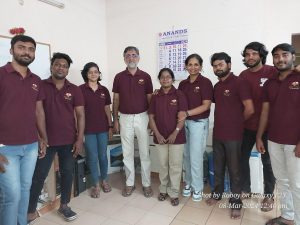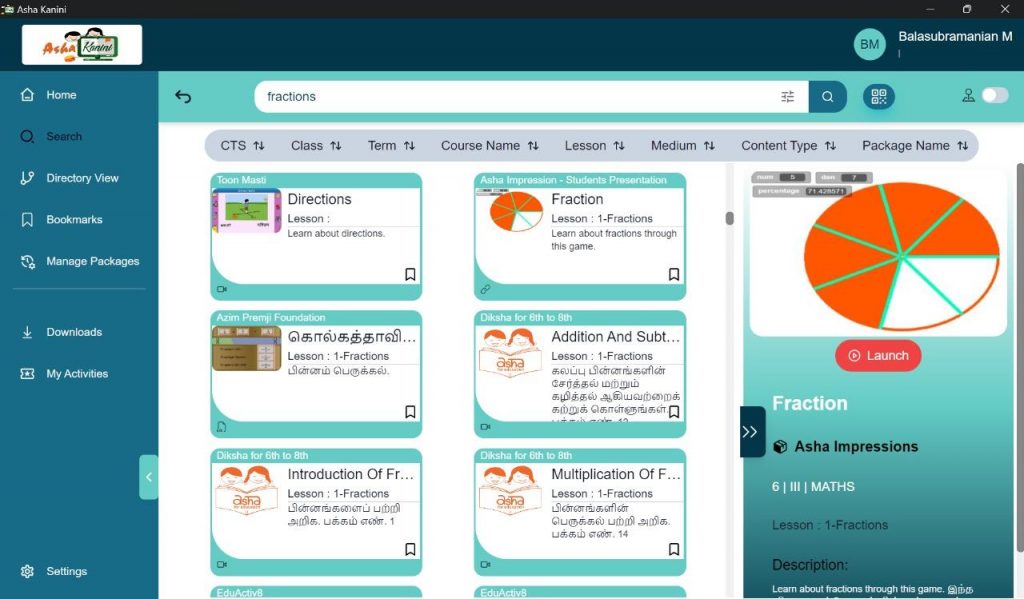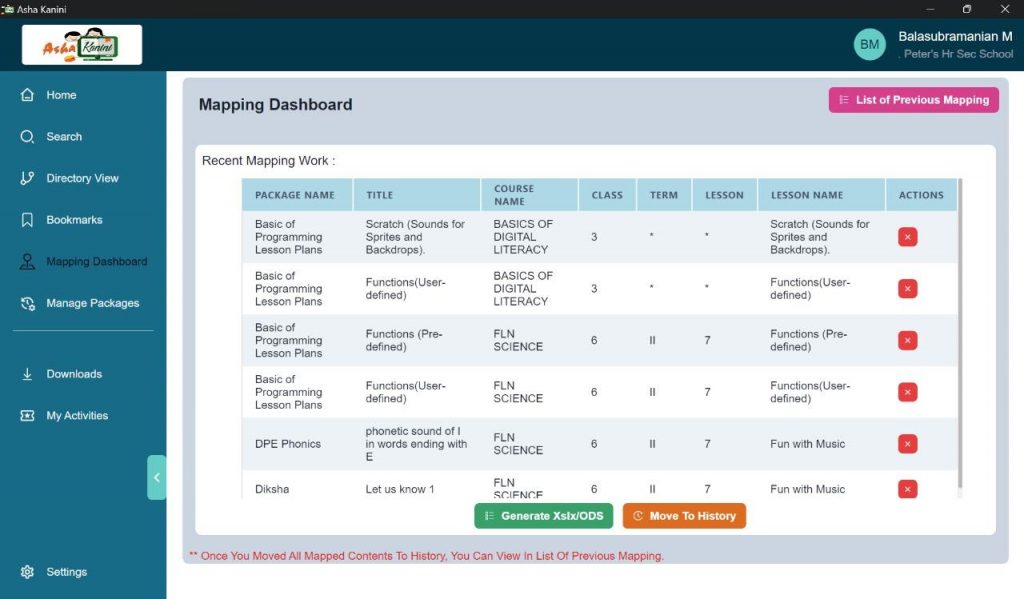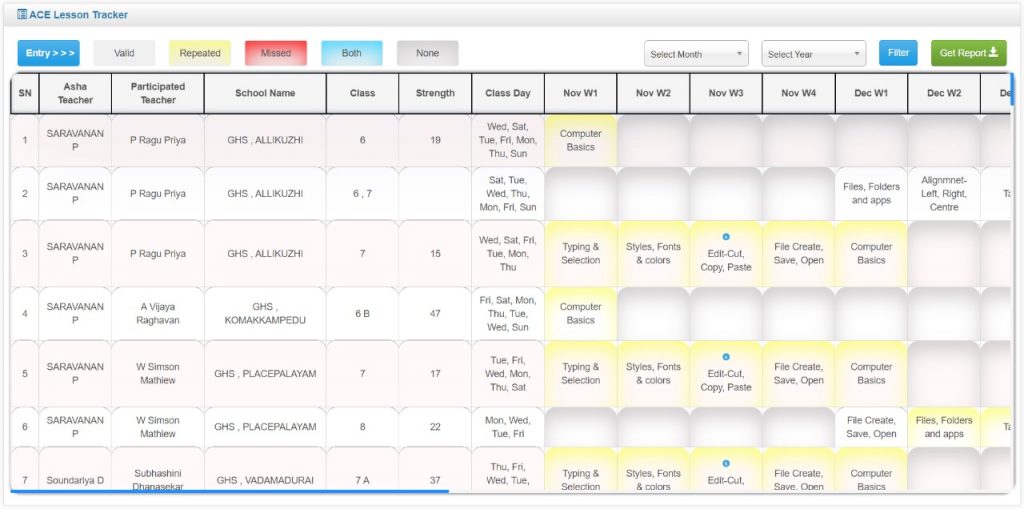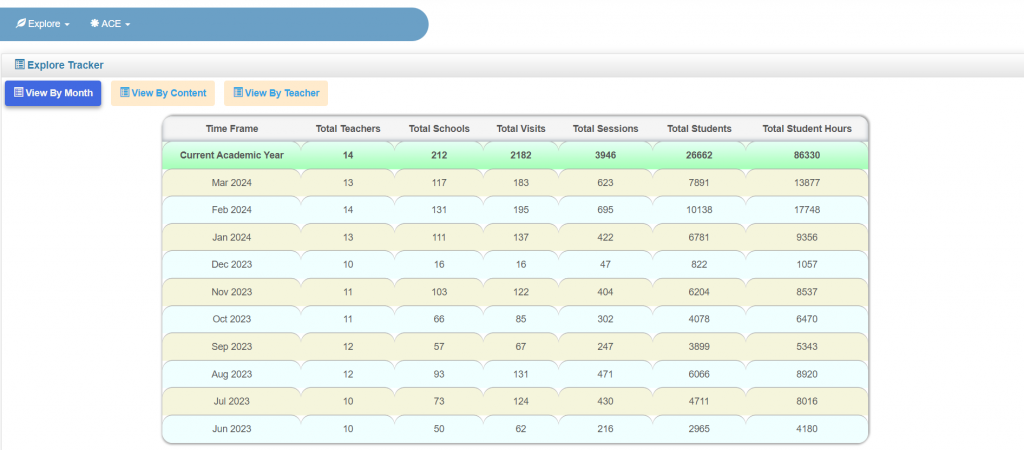Asha Kanini Report 2023-2024
Asha Kanini project started back in 2014-15 as a way to include teaching of computer science to students as well as finding a way to leverage use of technology to teach all subjects better. As it completes 10 years, many of its purposes have been achieved.
Computer Science curriculum for classes 1 to 8 is mature and has been implemented in over 180 schools in TN and UP. Several variants of it have been created to serve specific needs. Government teachers are using a 2 year curriculum to teach digital literacy and programming which is an abridged version of this same curriculum.
Asha Kanini, a software to access the best quality content in a very easy manner when teaching any lesson in any subject for classes 1 to 8. This has been made available for the TN and the UP state board curriculum.
Besides these, the Asha Kanini team has served as the IT backend for improving the performance of Asha Chennai as a whole ranging from processing and viewing Assessment data to tracking assets in our control.
Staffing:
During the year 2023-2024, our team has undergone expansion, now comprising five members. Joining the development team are Balasubramaniam and Hemanath. Balasubramaniam is actively engaged in the development of the forthcoming iteration of the Asha Kanini application, while Hemanath fulfills an intern role, contributing to various developmental aspects. Additionally, Rohit, a member of the software team, assumes responsibility for hardware and asset management and makes regular visits to the Sangamam office in Thiruvallur at least once weekly. Gomathy manages the team and Dhanasekar also works on the V4 related tasks.
- The team at Asha Chennai office
Asha Kanini Version 4:
Asha Kanini v4 is a major upgrade of our software. There are several system requirements met by this new version as well as new user features.
System Requirements
Since the original Asha Kanini version 3 was launched in 2019, several of the key dependencies have been upgraded. Node has moved from version 16 to 20, React from version 0.14 to 18.2, Electron from version 10 to version 26. Several module dependencies were also deprecated. MySQL version 8 is in use rather than 5.7. A new overhaul of Asha Kanini utilizing the more advanced features of these upgraded software, was long overdue.
Asha Kanini version 4 is presently under development to meet this need as well as other requirements. This iteration comes with the latest React and Electron modules and also aims to elevate UI interface, performance and efficiency.
- A snapshot of search in Asha Kanini v4
Enhanced Mapping Experience
At the beginning of each academic year, curriculum and textbook changes occur across different classes. Version 4 introduces a mapping interface that allows teachers to dynamically create and publish mappings for new or modified curriculum directly within the application. This streamlined process is several times faster and more efficient, offering teachers a visual tool to minimize errors in mapping and enabling seamless publication to the server.
This feature substantially alters the way package contents and mappings are handled both by the client and the server. We have introduced a Mongo DB to track the mappings and version control them in the server. The client uses an SQL lite database to manage the mapping and content configurations. This speeds up our search significantly.
- A view of the mapping interface for teacher in Asha Kanini v4
Enhanced Search
In version 4, we’ve made significant enhancements to our search functionality by leveraging the Fuse module and introducing multiple filter options. The Fuse module now supports fuzzy search, and we’ve improved how configuration is generated and options are managed. This results in more accurate search results across the platform.
Client Content Updates
We’ve restructured our configurations to be more dynamic and incremental. Unlike version 3, where updates required downloading entire packages even for small changes, version 4 supports incremental updates. This means that only the new content needs to be downloaded, significantly reducing data transfer size, especially for large packages. Moreover, the new version features loosely coupled configurations, optimizing client updates efficiently.
Data Reporting:
We’ve deployed data reporting systems for two active projects, ACE and Explore. Simultaneously, we’re in the process of establishing a comparable reporting structure for our computer teachers at primary and middle schools. These systems provide two important outputs.
Provide data on the number of sessions taken, number of hours taught, number of students reached etc. which are required for various reporting.
These also provide valuable insights into the progress and results of these initiatives.
As an example of the former, all the monthly data reporting for Amazon is derived from the data reported by the teachers.
Here are some examples of the latter.
ACE and computer teachers: The lesson tracker in ACE shows the progress of the one year CS curriculum on a weekly basis, tracking the sessions taught, missing and repeated sessions and observations by the computer teacher visiting the session. We plan to enhance this view to show the lesson completion status of all schools as a progressing bar graph. The bars will be built of small squares, each of which represent a lesson. Gaps in the bars will mean some lessons were skipped or not reported. Different colors on the graph will mean some lesson was repeated or done over two sessions. Length of the bars will indicate where the school is with respect to implementing the curriculum. This will provide the status of implementation of the curriculum in each school in a single glance.
- A view of the current ACE tracker.
Explore: Currently, the Explore report analyzes data collected from various perspectives including curriculum, school visits, and timeline. The report validates our assumptions regarding the number of daily sessions (average of 4), students per session (average of 15 to 20), and instructional days per year (average of 150 to 175).
Computer Teachers: In the Learn project, we will be implementing a tracker to monitor progress in computer science sessions, session frequency, adherence to schedules, and the number of teaching weeks for each teacher.
- A view of the Explore Tracker in the data reporting system
Assessment Processing
Teachers upload the list of students along with the student sociological details and the oral assessment status in Oct/Nov time frame. As the written assessment papers are ready, they upload the digitised version of the question papers to the server. The assessment graders then download the blank marksheet for all students in every class in a school and proceed to enter the marks for all questions in this and then upload the same to the server. The server validates all these uploads. Finally the school and teacher details are also uploaded. Reports on this data can be generated for all schools. Further lots of different analytics can be done on this data. These were all implemented in previous years. Several enhancements have been made to the process this year and a lot of support and management is required to ensure smooth processing of the data.
Further we started conducting assessments for Computer Science for students in classes 5 and 8. The work to support the upload of data for this as well as generating reports for the same was done this year.
Infrastructure and Administrative Support
The software engineers in the Asha Kanini team also provide IT support services for all of Asha Chennai. Here are some tasks that were taken up in 2023-24.
Asset Tracking and Validation
To fortify asset management protocols, QR code integration has been implemented. Each asset is generated a unique QR code which is stuck on the asset. Scanning the QR code validates the asset on the server. This validates the user scanning the QR code and optionally get a photo of the asset and its status from the user. This system ensures streamlined asset tracking and verification processes. The asset verification system helps to verify and tracks the teacher, project and other details of each asset.
Accounts Entry
We have implemented a facility for the accounts team to convert transactional data from Excel into a format compatible with our accounting software so that it can be uploaded directly without having to manually enter every transaction.
System Administration – Management
Rohit, from the development team, is also actively involved in administrative work, especially asset management. He regularly visits the sangamam office for the same. His responsibilities encompass asset management, hardware repairs, and overall infrastructure maintenance. This becomes especially important when we receive a batch of computers from donors. Last year we received 270 laptops from Amazon as well as 50 high end workstations from Ford. Readying these and allocating them to the various projects was handled by the Asha Kanini staff.
Plans for the coming year
In the upcoming year, our main priorities include launching the Asha Kanini v4 version for Windows and Android. As mentioned earlier, this update will incorporate several enhancements including a new Teacher mapping interface.
Additionally, we aim to implement the package processing module on the Sangamam server. This module will simplify the process for teachers to create and modify courses, packages, and mappings. In future, this framework in Asha Kanini v4 will enable teachers to dynamically generate lesson plans and teaching modules independently and publish them as needed. Furthermore, we plan to deploy two modules in Sangamam server, namely Teacher Scheduling and Learn Data Reporting. These tools will allow teachers to efficiently schedule school visits and track progress on lessons conducted under the Learn project.
The development team will also work with lead teachers and focus on creating courses for RTCs including Robotics, Artificial Intelligence and Advanced Web Development.
There are several other projects in the pipeline, such as, developing a bug tracking module for Asha Kanini, automating error tracking and server management, creating an assessment/worksheet module for the Kanini app, implementing dynamic lesson plans, allowing teachers to generate and share plans using the Kanini app and more.


